– Marcus, headfonics.com
For just over $1700 the NuPrime CDP-9 delivers extremely competently over a very wide range of feature sets. Primarily, people will see this as a CD Player, and certainly compared to my old flagship Meridian it competes very well indeed with additional detail and a very accurate yet decidedly “not” sterile in sound quality.
It is probably important to note right from the off that the review of the NuPrime CDP-9 will focus a little more on the DAC capabilities in a 2.1 or headphone setup rather than purely on the CD Player side.
I have had but two CD Players since the mid-90s, the Arcam CD72, and my current one, if you could call it that, the Meridian 506 20-BIT. Two excellent CD players I might add and the 506 was TOTL back in its day. I rarely upgrade when I find something I like.
It still works just fine which is a testimony to the build quality and parts inside that unit. From time to time I find myself looking for the CD72 in the local classifieds without much luck either. Those were the golden years of the CD.
The CDP-9 is priced in the same summit-fi zone as the Meridian once was (€1695). It is still fundamentally purposed as a CD Player but being 2018 and priced as it is the CDP-9 brings a lot more to the table than simply spinning 16BIT 44.1kd discs. This will definitely appeal to component system builders and digital source audiophiles also.
WHAT DOES IT DO?
CD PLAYBACK
This is NuPrime’s flagship CD player and more feature packed than their mid-priced CDT-8 Pro (8-series). NuPrime has shared some features between the two such as using a Philips SAA7824HL laser and a single speed solution to minimize vibration and unbalanced disc playback.
Note, the CDP-9 will not decode SACD or other associated hi-res formats on disk. It is still a traditional CD Player in that respect though NuPrime touts its Red Book error correction capability. It also differentiates itself by delivering a lot more inputs and outputs with an internal DAC whereas the CDT-8 Pro is a pure transport.
Though the CDP-9 is primarily a physical format player it does throw in a number of interesting features to enhance the playback capability of CD’s and become more relevant to system builders.
ES9028PRO
The first is the use of the newer Sabre Es9028PRO DAC implementation. Whilst not a be all and end all statement it does raise the decoding capability significantly from 44.1kHz to 768kHz or DSD64 to DSD512.
SAMPLE RATE CONVERTER
The CDP-9 taps into that enhanced decoding capability by adding a sample rate converter via FPGA that will upsample to megahertz before converting into the target sample rate. So, for instance, a 44.1K CD can be upsampled to DSD512 or PCM 768KHz, as can a digital fed into the CDP-9 from another wired source.
STANDALONE DAC
It also means the CDP-9, combined with a range of inputs and outputs, can suffice as a standalone DAC for wired digital signal input from other sources such as your PC/MAC or streaming device. The sample rate converter feature can be equally applied to these files.
AMPING
The CDP-9 will output to headphone albeit through a 3.5mm jack out at 150mW into 32Ω. I would not consider this to be the primary driver to buy the CDP-9 and those power ratings are more for IEM than planar. Of far more use will be the pre-amp capability of the CDP-9 which is something NuPrime have done a lot with their component systems such as the DAC-9 and DAC-10.
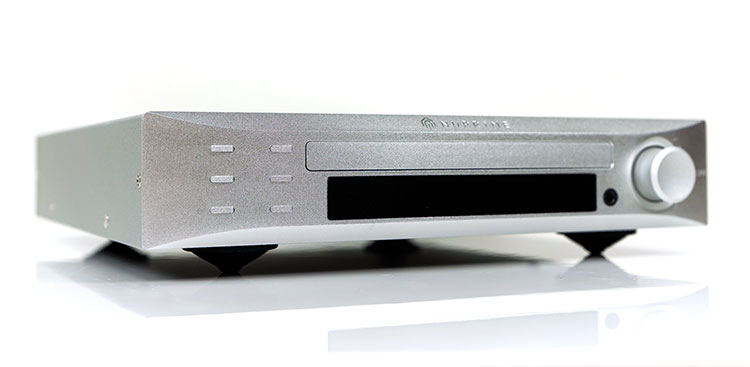
BUILD QUALITY
FORM FACTOR
The CDP-9 form factor is much the same as the HPA-9 and the DAC-9. It is part of the 9-series after all so it has a slim modern and curved facia design to the front and a slightly boxier regular build to the rear. I would class the dimensions as mid to small sized for a component unit measuring in at 235 mm W x 281 mm D x 55 mm (including the feet).
If you do own the HPA-9 and DAC-9 it will stack on top of those two units and you can, like Cayin and their I-Series, build a compact but complete headphone and component system. Both of these have form factors and dimensions that are the exact same spec so you have no issues on any possible overhang.
Like the previous two 9-series units, the CDP-9 has four well-built shock absorbing feet on the base which I consider a must for any CD player, especially for stacking or close to any powerful speaker pairings. You do not want a TOTL unit skipping due to unwanted vibrations.
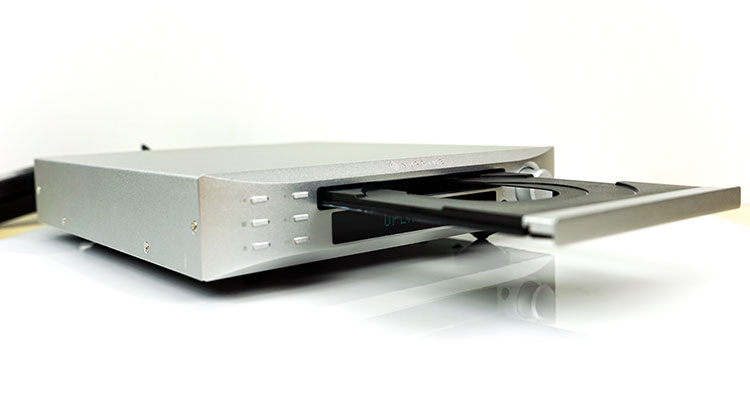
TRAY LOADER
The CDP-9 also uses an aluminum and plastic tray load system as opposed to a slot or top loading mechanism. It loads very smooth and straight though the plastics have a touch of wobble right at the last second when opening. I would also avoid placing any accidental pressure on the tray but that is just common sense for all tray loaders.
Mind you, I am a huge fan of excessively deep ‘drawer’ loading tray designs and one of the main reason why I still have the Meridian 506 today. The 506 drawer is not just a loader but the transport itself with a linear 3-beam pickup is a Foucault focus arrangement. Hence the depth is really required to keep everything super steady. The transport on the CDP-9 is static inside the main body hence the thinner tray mechanism as its only purpose is to load the CD.
DISPLAY
This is the first NuPrime component system we have reviewed with a true LCD type display with up to 12 individual LED clusters covering both alpha and numeric. Previously the DAC-9 and DAC-10 have used diode bulb configurations behind the main aluminum plating which are fine but this is a bit of step up. It is not angled like the Cayin iDAC-6 display but I found I didn’t have any viewing difficulties at extreme angles.

In some ways, it needed to be a step up with the multiple source options available and to be frank at this price point nothing less would do. For example, in CD playback, this is where the screen will cover the widest range of options and information. It will offer feedback such as playback mode, tracks and total time in CD player mode. It will also show information on scanning, forward, reverse, repeat and the actual playback mode such as shuffle or shuffle repeat.
INPUTS & OUTPUTS
The front is fairly clean in terms of inputs and outputs. In fact, just the one output which is a 3.5mm single-ended jack port for headphone and IEM use. The big input of course is the front slot loader which we have already covered. The rest are primarily physical controls. The majority of the connections are on the rear panel.
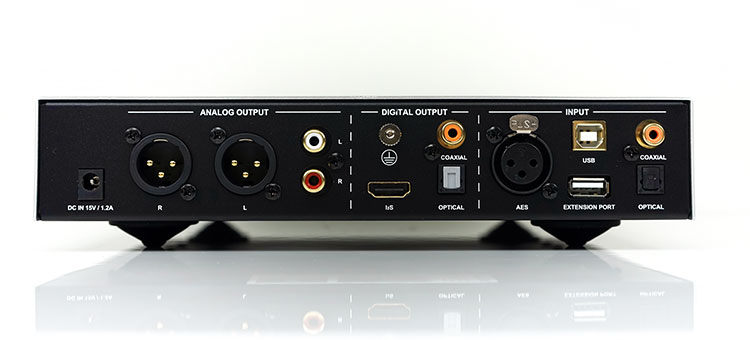
OUTPUTS
The CDP-9 offers a wide variety of digital inputs and outputs as well as both balanced and unbalanced analog outputs. It does not offer any wireless or streaming functionality as stock such as you would find on the Cayin iDAP-6. However, it does offer the ability to plug in an optional service via an extension port on the rear. The analog output is via an XLR 3-pin balanced left/right connection and dual RCA unbalanced out so it can offer a true balanced output of up to 8Vrms and slot in with a reciprocal balanced analog amp.
The digital outputs include coaxial, optical and I2S. I2S has been around for a while and will work with a standard HDMI cable and is touted as having excellent jitter control. Traditional interfaces, such as S/PDIF, mix the clock and data signals and must go through an additional conversion process which increases jitter. Supposedly I2S will produce a much cleaner signal, especially at higher frequency levels.
However, you need a source with an I2S output device to receive the signal into the CDP-9. For example, the Cayin iDAP-6 streamer can connect with the CDP-9 via an I2S link-up. This will basically transport streaming into the CDP-9 DAC and support 8-32BIT audio sample rates.
INPUTS
On the input side, you have an ABS/EBU balanced connection, USB, coaxial, optical and a single USB-A extension port. The extension port will allow you to stream via Bluetooth or WiFi if you have a USB-A female jack interfacing module. The USB will primarily interface with a PC/MAC for digital audio streams and likely to be the primary source if you have hi-res DSD. All connections have various sample rate capabilities as follows
- USB Sampling Rates: up to PCM 768KHz and 22.6MHz(DSD512)
- Coaxial Sampling Rates: up to PCM 768KHz and Dop256
- Optical Sampling Rates: up to PCM 192KHz and Dop64
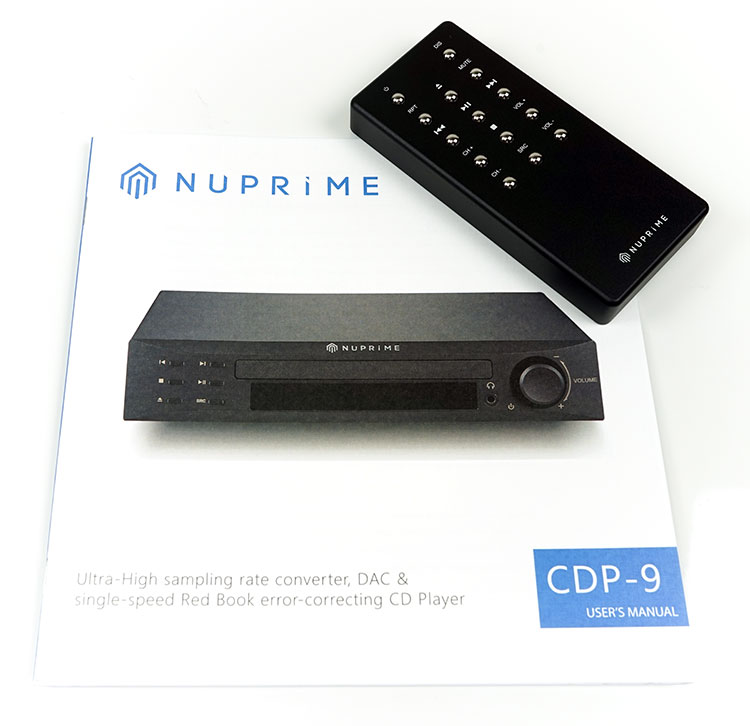
REMOTE CONTROL
Well, certainly it is an upgrade on the ‘stone age club’ design of the DAC-10H and more uniform in shape. However, it is still a bit of a tank, loud and clicky and you do have to unscrew the backplate to change the battery. I will give it props for it being incredibly sturdy (aluminum) and mechanical in nature but I am struggling to remember the last time I ever broke a remote control. Perhaps a slimmer design with quicker battery changing capability would fare better.
Aside from that it pretty much mirrors what can be done on the front fascia with tray operation and playback control for CDs. It will also allow you to select your desired source sample rate level, adjustor mute volume as well as selecting the desired source channel such as optical, USB or coaxial.
There is also a little “dis” button to flick between the various display information elements on the LED display such as volume level, disk status etc. In practice, I had little or no need to touch the front panel of the CDP-9 except when the clicking noise of the remote got a bit irritating.
INTERNAL HARDWARE
DAC
Surprisingly NuPrime has not mentioned the DAC implementation in any great detail outside of the decoding and FPGA sampling rate prowess which, in fact, it is very good at. They should. It is a good DAC chipset, the Sabre ES9028PRO. This is a 32BIT 8-channel capable chipset with up to 129dB in dynamic range (DNR).
Whilst it is not an ES9038PRO, which I would have loved to have seen in the CDP-9, it is nevertheless a thoroughly modern DAC with excellent dynamic range capability.
I cannot account for every ES9028/38PRO implementation but the ones I have heard thus far have been a lot smoother and more detailed sounding than some older ES9018 infused units. The Oppo Sonica DAC was a very good example of just how much nicer the newer chips could sound in the right hands.
AMP
HEADPHONE
The opamp designed headphone amp for me is more of a gentle bonus than a huge selling feature. It is no great shakes in terms of power at 150 mW @ 1 kHz into a 33Ω load. Certainly, nowhere near the level of their excellent DAC-10H integrated headphone DAC/amp for driving big cans.
It will, however, pair very impressively with IEMs, even efficient ones with low impedance and portable headphones below 32Ω. The CDP-9 headphone amp has a very quiet output stage with next to no noise or background hiss, excellent channel balancing and no low impedance skew.
PRE-AMPING
Pre-amping is excellent with up to 8Vrms output via the balanced connection and a very wide range of control via the CDP-9’s built-in volume dial using up to 100 steps in 0.5dB incremental. The CDP-9 uses an independent variable resistor-based volume system controlled by the ARM chipset microcontroller so it is very even and accurate. Call it a hybrid analog/digital system if you will.
I would encourage you to try balanced over single-ended for the superior voltage levels and much better gain levels on amps such as the Violectric V281. I found the V281 dial to be up much higher with unbalanced connections.
CD PLAYBACK
The CDP-9 uses a Philips SAA7824HL servo system and triple beam laser for CD playback which is then sent to an ARM chip LPC2103F CD for error correction. This is an all in one system for the drive, lens, and tracking.
This is a system I have seen in a few high-end systems such as the Shanling CD 3.2 and MHZS units. It is also the same servo unit used in the CDT-8 Pro and a quite a few mid-fi CD players from aforementioned brand names.
SOUND IMPRESSIONS
AS A PURE DAC
The CDP-9 retains the hallmarks of a well implemented new generation Sabre DAC (ES9028PRO) in terms of excellent resolution, micro-detail, and very good instrumental separation. However, NuPrime has tweaked the presentation in a way that is slightly different from the generally smooth but very linear tone of the likes of the Sonica DAC or even the Hugo 2.
PUNCHY
The CDP-9 is a little more energetic and impactful than I expected it to be. I would still call it a neutral and clean sound in terms of delivering a fairly accurate instrumental timbre, however, its low-end is a touch punchier than I expected, not quite flat or dead neutral. Its sub-bass presence with a transparent amp such as the Violectric V281 is just that bit more elevated than what I found with the Sonica.
I would not quantify the extent of the low-end impact to the same level as the Cayin iDAC-6. The iDAC-6 used an older AK4490 chipset and played to its musical strengths so it is the weightier of the two. However, the CDP-9 dynamic range and quicker transient response were actually very satisfying and far more immediate sounding than I presumed it would be. To call this presentation sterile would be wide of the mark.
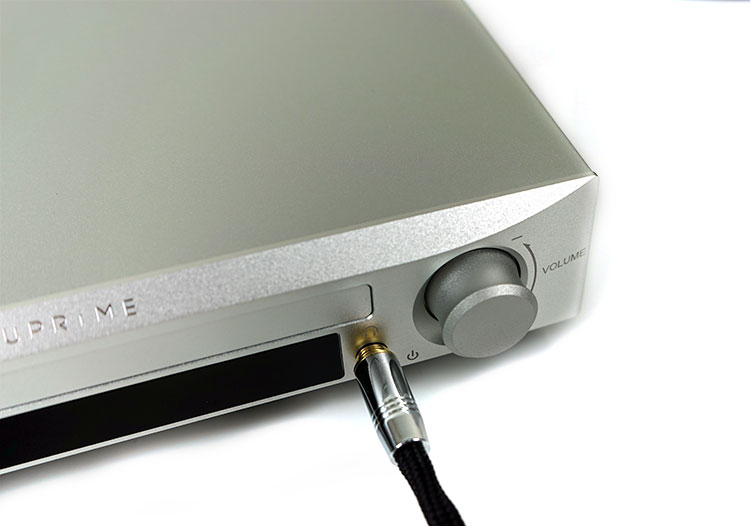
ENERGETIC
NuPrime has also kept a fairly energetic and more forward upper mids and treble response in the CDP-9. This is not to be confused with bright however it is a cleaner and less neutral sound than the Sonica or even the Hugo 2. You will get a little more odd-harmonic emphasis so I would not describe quite as smooth and natural in higher pitched percussion and string timbre. Instead, you get more emphasis on note leading edges which in turn produces a perceptibly more exciting sound. Percussion has snap and plucked strings are very tightly controlled and well defined with the CDP-9 as a DAC.
I am also impressed with the CDP-9 staging capability. There is definitely a bit more width than the Hugo 2 and more depth than the Sonica. Height is very good also with NuPrime not holding back with any top-end energy and resisting rolling it back.
AS A CD PLAYER
The CDP-9 as a CD Player will deliver most if not all of the DAC presentation. It remains a fairly quite neutral sounding source with an expansive soundstage, excellent instrumental separation and plenty of detail. It is actually quite faithful my perception that Sabre ES9028/38 PRO infused component systems tend to be quite coherent, balanced and resolving in their presentation but without sounding harsh.
Certainly, compared to my old flagship Merdian 506 20BIT CD Player presentation it is a little more linear and open sounding, particularly in the mids and treble performance. The 506 adds a touch more low-end weight and warmth, a more intimate midrange with a very natural sounding instrumental timbre and vocal presence as well as a more relaxed treble performance. If anything, the Meridian sounds the more analog of the two, the more musical with that weightier low-end and warmer tone, but not quite as detailed or as accurate sounding as the CDP-9.
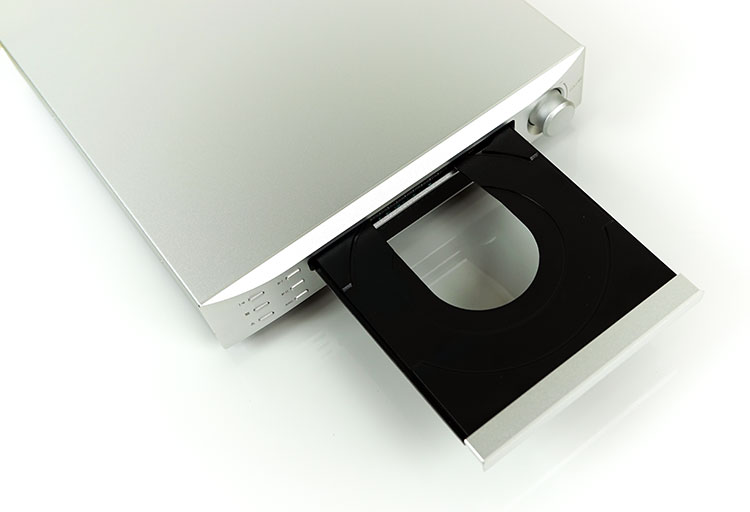
HEADPHONE AMP
At 150mW into 32Ω, the CDP-9 opamp infused headphone output is actually very quiet and impressive sounding for IEMs and easy to drive headphones such as the 1MORE Triple driver over ear or the Meze 99 Classic/Neo range. The hybrid digital/analog volume system was excellent for channel balance on sensitive IEMs and not a lick of noise or background hiss present, a very black background indeed.
We did try it with the MrSpeakers AEON closed back planar to get a sense of the power handling performance. Volume control was actually pretty good at around 40-45 steps. However, I felt the performance was a touch too sharp which is where the AEON tends to go when underpowered. The AEON is rated at just 13Ω and 93dB sensitivity so a quality powerful amp will always provide a more engaging and smoother sound. Switching the CDP-9 to line out with the Violectric V281 headphone amp immediately introduced a smoother sound with better dynamic range.
SRC PERFORMANCE
DSD
Switching to sample rate converter DSD leads to a minute loss of dynamic range and maybe 0.5 to 1dBdB of volume. It sounds a little smoother with a slightly softer attack (DSD512 upsampling) and vocal presence definitely lacked a bit of presence from the original recording.
If anything, I got the impressions the higher frequency range in the DSD upsampling was just a little more rolled off. You could argue the SRC DSD upsampling is more listenable and even the more natural of the two, particularly if the original recording is bright and aggressive. However, to my ears, it lacks a little pop or contrasting enough to sound as engaging as the original.
My own preference is to leave the SCR option off or use the PCM upsampling option instead.
PCM
PCM upsampling seemed to fare much better for me with a bit more contrast and higher frequency presence. Definitely did not feel any loss in dynamic range. PCM 88 and 96 upsampling seems to gel best with my listening preferences with a slightly fuller sounding low end and a bit more punch and dynamic presence.
Here the upsampling felt finely balanced between a natural sound and one that delivered a bit more space and 3D dimensional positioning to the original non-sampled playback. The further up I went it got a little more digital sounding and less natural sounding for me on a personal level but it was interesting to hear what a 768kHz rate could potentially sound like.
SELECT DAC COMPARISONS
OPPO SONICA
$799
PERFORMANCE
I had a perception that they would sound quite similar. True enough they are not quite as weighted as musical as the iDAC-6, electing instead to plow a more linear path but there are some differences to their tonality. In a nutshell, the CDP-9 aims for articulation, control, and clarity whereas the Sonica is tweaked for a little more of a smoother natural sound.
The CDP-9 is just that bit more dramatic sounding than the Sonica at times. Key areas where it outperforms is the greater level of dynamic range, a bit more sub-bass presence and the cleaner of the two in terms of instrumental separation.

The Oppo pulls back a little with a slightly warmer lilt and a little less treble forwardness to get that smoother sound. The Sonica tends to center any warmth it has in the mid-bass and lower mids where it sounds a little smoother, richer maybe but also more relaxed sounding. The attack on the Sonica is a hair smoother sounding and the timbre also a little richer.
The CDP-9 also has the better staging properties of the two DACs with that greater depth and also a little more treble presence and air. In comparison, the CDP-9 has the more holographic or 3-dimensional presentation with excellent imaging. The CDP-9 also sounds the cleaner of the two in the upper mids and lower treble performance. With acoustical work, the CDP-9 is going to sound a little more precise, sharper sounding but not sharp per se.
HUGO 2
£1,800.00
PERFORMANCE
A very tough contest here to be honest for the CDP-9 in terms of micro-detail and dynamic range. The Hugo 2 is ahead for me on that score and sounds the more natural of the two also. Given its loftier price, it shouldn’t be surprising.
It takes the best traits of the Sonica such as that refined and smooth attack and the dynamic range of the CDP-9 and enhances both to deliver one of the most coherent and balanced sounding presentations you will hear from a DAC in this price range.
The Hugo 2 will sound the punchier of the two, leaving the Sonica sounding rather flat in that respect and edging ahead of the CDP-9’s bass performance which I in turn rate as a bit livelier than the Sonica.
The treble performance is more Sonica than CDP-9. It is not quite as lively as the CDP-9 but then it’s not as laid back or smooth as the Sonica. I think it gets the balance very right indeed. So right, some might actually think it’s a touch boring sounding which could work to the CDP-9’s advantage in some respects.
That livelier treble of the CDP-9 does open it up to delivering a perceptibly airier and slightly wider soundstage than the flatter and more linear Hugo 2. Just a little more left/right separation and more bass/treble contrast on the Hugo 2.
CAYIN IDAC-6
$699
PERFORMANCE
The Cayin iDAC-6 has more depth, heft and sub-bass presence. You will hear more low-end physicality and a bit more quantity. It delivers a smooth natural sounding timbre but it is also a tiny bit laid back in the treble and lower mids compared to the CDP-9. The lower treble has that distinctive AK4490 hardness though. It is not quite “Sabre glare” but it can jar and sound a little brittle in comparison to the CDP-09.

The CDP-9 top-end is more energetic and perhaps the cleaner of the two but it also sounds a touch more refined and smoother in its delivery. Good treble as they say.
I also find the midrange performance of the CDP-9 as a DAC a little more balanced. The iDAC-9 is excellent with more vocal presence but the lower mids are toned down a little in favor of more bass presence so it not quite as neutral and coherent sounding. The CDP-9 lower mids presence is just that bit clearer, perhaps even slightly fuller sounding but with better layering and instrumental separation.

OUR VERDICT
FEATURE RICH
For just over $1700 the NuPrime CDP-9 delivers extremely competently over a very wide range of feature sets. Primarily, people will see this as a CD Player, and certainly compared to my old flagship Meridian it competes very well indeed with additional detail and a very accurate yet decidedly “not” sterile in sound quality.
However, there is much more to it than that. The big attraction for me is the DAC features with both analog and digital inputs and outputs as well as the bonus feature of being able to drive efficient IEMs and headphones from a headphone amp. The hybrid volume control and opamp design of the CDP-9 will deliver excellent channel balance and very black background with next to no noise.
For those coming from similar modern Sabre DAC infused DACs such as the Sonica from Oppo you will find that the CDP-9 is just that bit livelier and more engaging. This is a clean sound but an energetic and 3-dimensional performance.
The SRC function up to around 96k PCM is actually quite interesting and something I would use. However, the higher up we go the more digital it started to sound. The DSD version also sounded a little more muted for me than the PCM options. A question of preferences though because the DSD lower bitrates did sound quite smooth.
TWEAKS
What could be improved? One main feature that springs to mind is the remote control. It is an improvement on the unusual DAC-10H remote and granted it is very robust. However, the mechanical sound and large clicking noises, as well as the awkward battery changing process make it feel archaic in nature. Something slimline, quieter in execution and with a slide-off battery lid would be an improvement.
Overall, the NuPrime CDP-9 is a thoroughly modern and very interesting CD Player, DAC, pre-amp and headphone amp. There is a bit of something for everyone and a level of sound quality that is easily on par with some of our favorite reviewed DAC’s to date.
Link to the review -->https://headfonics.com/nuprime-cdp-9-review
